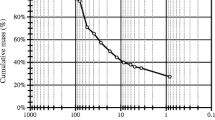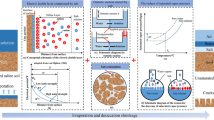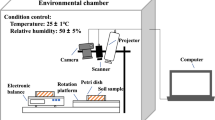Abstract
Desiccation cracking significantly affects the unsaturated permeability (Kunsat), which governs the water diffusion in the soil in several engineering applications, such as slope stability, road embankments, long-term risk assessment from waste disposal sites, recharge for groundwater hydrogeology, petroleum, and CO2 storage. Cracking causes the permeability to increase, which is cited as the cause of failure and damage in a number of the aforementioned works. This paper aims to experimentally study the unsaturated permeability (Kunsat) of a clayey soil during desiccation. Similar to the instantaneous profile method (IPM), a new method was developed that is based on evaporation tests and water retention curve (SWRC) and takes into account the strains caused by shrinkage and cracks. Different initial states of a clayey soil are examined including a slurry soil prepared at the liquid limit water content and compacted soil with varying initial densities on the wet part on the normal optimum proctor (NPO). Two additional image methods were used: the DIC technique (digital image correlation) to investigate the strain field before cracking and the IAT (image analysis technique) to study the growth of cracks. It was demonstrated that Kunsat was well related to the initial state in terms of density and moisture content. When the suction reaches the entry suction value, Kunsat decreases when the suction increases without the appearance of desiccation cracks. Otherwise, it increases with the growing intensity of the cracks. The proposed experience protocol allowed for different initial states (density and water content) to be considered in a large suction range without the use of proximity sensors.



















Similar content being viewed by others
Availability of data and material
The datasets used and/or analyzed during the current study are available from the corresponding author on reasonable request.
References
An N, Tang CS, Xu SK, Gong XP, Shi B, Inyang HI (2018) Effects of soil characteristics on moisture evaporation. Eng Geol 239:126–135. https://doi.org/10.1016/j.enggeo.2018.03.028
Birle E, Heyer D, Vogt N (2008) Influence of the initial water content and dry density on the soil–water retention curve and the shrinkage behavior of a compacted clay. Acta Geotech 3(3):191–200
Blackwell PS, Graham JP, Armstrong JV, Ward MA, Howse KR, Dawson CJ, Butler AR (1986) Compaction of a silt loam soil by wheeled agricultural vehicles. I. Effects upon soil conditions. Soil Tillage Res 7(1–2):97–116
Cheng Q, Tang CS, Zeng H, Zhu C, An N, Shi B (2020) Effects of microstructure on desiccation cracking of a compacted soil. Eng Geol 265:105418. https://doi.org/10.1016/j.enggeo.2019.105418
Costa S, Kodikara J, Thusyanthan NI (2008) Study of desiccation crack evolution using image analysis. Unsaturated Soils Adv Geo-Eng pp 175–180
Costa S, Kodikara JK, Shannon B (2013) Salient factors controlling desiccation cracking of clay in laboratory experiments. Géotechnique 63(1):18–29
Delage P, Howat MD, Cui YJ (1998) The relationship between suction and swelling properties in a heavily compacted unsaturated clay. Eng Geol 50(1–2):31–48
El Hajjar A, Ouahbi T, Eid J, Hattab M, Taibi S (2020) Shrinkage cracking of unsaturated fine soils: new experimental device and measurement techniques. Strain. John Wiley & Sons Ltd. https://doi.org/10.1111/str.12352
El Hajjar A, Ouahbi T, Taibi S, Eid J, Hattab M, Fleureau JM (2021) Assessing crack initiation and propagation in flax fiber reinforced clay subjected to desiccation. Constr Build Mater. https://doi.org/10.1016/j.conbuildmat.2021.122392
Eid J, Taibi S, Fleureau JM, Hattab M (2015) Drying, cracks and shrinkage evolution of a natural silt intended for a new earth building material. Impact of reinforcement. Constr Build Mater 86:120–132
Fleureau JM, Kheirbek-Saoud S, Soemitro R, Taibi S (1993) Behavior of clayey soils on drying–wetting paths. Can Geotech J 30(2):287–296
Fujimaki H, Inoue M (2003) A flux-controlled steady-state evaporation method for determining unsaturated hydraulic conductivity at low matric pressure head values. Soil Sci 168(6):385–395
Gueddouda MK et al (2016) Hydraulic properties of dune sand–bentonite mixtures of insulation barriers for hazardous waste facilities. Journal of Rock Mechanics and Geotechnical Engineering 8(4):541–550
Groisman A, Kaplan E (1994) An experimental study of cracking induced by desiccation. Europhys Lett 25(6):415–420
Hallett PD, Newson TA (2001) A simple fracture mechanics approach for assessing ductile crack growth in soil. Soil Sci Soc Am J 65(4):1083–1088
Hattab M, Taibi S, Fleureau JM (2020) Mud shrinkage and cracking phenomenon experimental identification using digital image correlation. Dynamics, Strength of Materials and Durability in Multiscale Mechanics pp 379–403
Horn R, Domżżał H, Słowińska-Jurkiewicz A, Van Ouwerkerk C (1995) Soil compaction processes and their effects on the structure of arable soils and the environment. Soil and Tillage Research 35(1–2):23–36
Julina M, Thyagaraj T (2019) Quantification of desiccation cracks using X-ray tomography for tracing shrinkage path of compacted expansive soil. Acta Geotech 14(1):35–56
Julina M, Thyagaraj T (2020) Combined effects of wet-dry cycles and interacting fluid on desiccation cracks and hydraulic conductivity of compacted clay. Eng Geol 267:105505. https://doi.org/10.1016/j.enggeo.2020.105505
Lakshmikantha MR, Prat PC, Ledesma A (2009) Image analysis for the quantification of a developing crack network on a drying soil. Geotech Test J 32(6):505–515
Li P, Shao S, Xiao T, Zhu D (2021) Pore-size distribution evolution of intact, compacted, and saturated loess from China during consolidation and shearing. Adv Civil Eng. https://doi.org/10.1155/2021/6644471
Louati F, Mabrouk A, Trabelsi H, Jamei M, Zenzri H (2021) Flow exchange and unsaturated permeability of cracked clay: experimental and modelling. Eur J Environ Civil Eng 1–17.https://doi.org/10.1080/19648189.2021.1989051
Louati F, Trabelsi H, Jamei M, Taibi S (2018a) Impact of wetting-drying cycles and cracks on the permeability of compacted clayey soil. Eur J Environ Civil Eng 1–26. https://doi.org/10.1080/19648189.2018.1541144
Louati F, Houcem T, Jamei M (2018b) Unsaturated permeability prediction using natural evaporation method in cracked clay. Proceedings of the 7th International Conference on Unsaturated Soils, Hong Kong, China. https://www.issmge.org/publications/online-library. Accessed 7 August.
Marinho FA (2005) Nature of soil–water characteristic curve for plastic soils. Journal of Geotechnical and Geoenvironmental Engineering 131(5):654–661
McNabb DH, Startsev AD, Nguyen H (2001) Soil wetness and traffic level effects on bulk density and air-filled porosity of compacted boreal forest soils. Soil Sci Soc Am J 65(4):1238–1247
Miller CJ, Yesiller N, Yaldo K, Merayyan S (2003) Closure to “impact of soil type and compaction conditions on soil water characteristic” by CJ Miller, N. Yesiller, K. Yaldo, and S. Merayyan. J Geotech Geoenviron Eng 129(12):1169–1170
Peron H, Hueckel T, Laloui L, Hu L (2009) Fundamentals of desiccation cracking of fine-grained soils: experimental characterisation and mechanisms identification. Can Geotech J 46:1177–1201
Rodríguez R, Sanchez M, Ledesma A, Lloret A (2007) Experimental and numerical analysis of desiccation of a mining waste. Can Geotech J 44(6):644–658
Romero E, Gens A, Lloret A (1999) Water permeability, water retention and microstructure of unsaturated compacted Boom clay. Eng Geol 54(1–2):117–127
Romero E, Gens A, Lloret A (2001) Temperature effects on the hydraulic behaviour of an unsaturated clay. Unsaturated soil concepts and their application in geotechnical practice. Springer, Dordrecht, pp 311–332
Salager S, Nuth M, Ferrari A, Laloui L (2013) Investigation into water retention behaviour of deformable soils. Can Geotech J 50(2):200–208
Schindler U, Doerner J, Mueller L (2015) Simplified method for quantifying the hydraulic properties of shrinking soils. J Plant Nutr Soil Sci 178(1):136–145
Sun DA, Sheng D, Xu Y (2007) Collapse behaviour of unsaturated compacted soil with different initial densities. Can Geotech J 44(6):673–686
Sun DA, You G, Annan Z, Daichao S (2016) Soil–water retention curves and microstructures of undisturbed and compacted Guilin lateritic clay. Bull Eng Geol Env 75(2):781–791
Tang C, Shi B, Liu C, Zhao L, Wang B (2008) Influencing factors of geometrical structure of surface shrinkage cracks in clayey soils. Eng Geol 101(3–4):204–217
Tang CS, Cui YJ, Shi B, Tang AM, Liu C (2011) Desiccation and cracking behaviour of clay layer from slurry state under wetting–drying cycles. Geoderma 166(1):111–118
Tessier D (1975) Recherches expérimentales sur l’organisation des particules dans les argiles. Application à l'étude de 4 pâtes argileuses" calciques" en voie de dessiccation (Doctoral dissertation, l'auteur)
Trabelsi H, Jamei M, Zenzri H, Olivella S (2012) Crack patterns in clayey soils: Experiments and modeling. Int J Numer Anal Meth Geomech 36(11):1410–1433
Trabelsi H, Romero E, Jamei M (2018) Tensile strength during drying of remoulded and compacted clay: The role of fabric and water retention. Appl Clay Sci 162:57–68. https://doi.org/10.1016/j.clay.2018.05.032
Vanapalli SK, Fredlund DG, Pufahl DE (1999) The influence of soil structure and stress history on the soil–water characteristics of a compacted till. Geotechnique 49(2):143–159
Wang JD, Li P, Ma Y, Vanapalli SK (2019) Evolution of pore-size distribution of intact loess and remolded loess due to consolidation. J Soils Sediments 19(3):1226–1238
Wang Y, Feng Di, Ng CWW (2013) Modeling the 3D crack network and anisotropic permeability of saturated cracked soil. Comput Geotech 52:Pages 63–70
Wei X, Bicalho K, El Hajjar A, Taibi S, Hattab M, Fleureau J (2020) Experimental techniques for the study of the cracking mechanisms in drying clays. Geotech Test J 2:323–338. https://doi.org/10.1520/GTJ20190430
Wei X, Hattab M, Taibi S, Bicalho KV, Xu L, Fleureau JM (2021) Crack development and coalescence process in drying clayey loess. Geomech Eng 25(6):535–552
Williams J, Shaykewich CF (1969) An evaluation of polyethylene glycol (PEG) 6000 and PEG 20,000 in the osmotic control of soil water matric potential. Can J Soil Sci 49(3):397–401
Xu P, Zhang Q, Qian H, Qu W, Li M (2020) Microstructure and permeability evolution of remolded loess with different dry densities under saturated seepage. Eng Geol 282:105875. https://doi.org/10.1016/j.enggeo.2020.105875
Yan C, Zheng Y, Ke W, Wang G (2021) A FDEM 3D moisture migration-fracture model for simulation of soil shrinkage and desiccation cracking, Comput Geotech 140. https://doi.org/10.1016/j.compgeo.2021.104425.
Zhou AN, Sheng D, Li J (2014) Modelling water retention and volume change behaviours of unsaturated soils in nonisothermal conditions. Comput Geotech 55:1–13
Funding
The authors extend their appreciation to the deputyship for research and innovation, Ministry of Education in Saudi Arabia for funding this research work through the project number “IF_2020-NBU_459”.
Author information
Authors and Affiliations
Corresponding author
Ethics declarations
Conflict of interest
The authors declare no competing interests.
Rights and permissions
Springer Nature or its licensor (e.g. a society or other partner) holds exclusive rights to this article under a publishing agreement with the author(s) or other rightsholder(s); author self-archiving of the accepted manuscript version of this article is solely governed by the terms of such publishing agreement and applicable law.
About this article
Cite this article
Louati, F., Trabelsi, H., Alassaf, Y. et al. Unsaturated permeability of clayey soil during desiccation: combined evaporation-shrinkage-cracking. Bull Eng Geol Environ 82, 220 (2023). https://doi.org/10.1007/s10064-023-03202-7
Received:
Accepted:
Published:
DOI: https://doi.org/10.1007/s10064-023-03202-7




